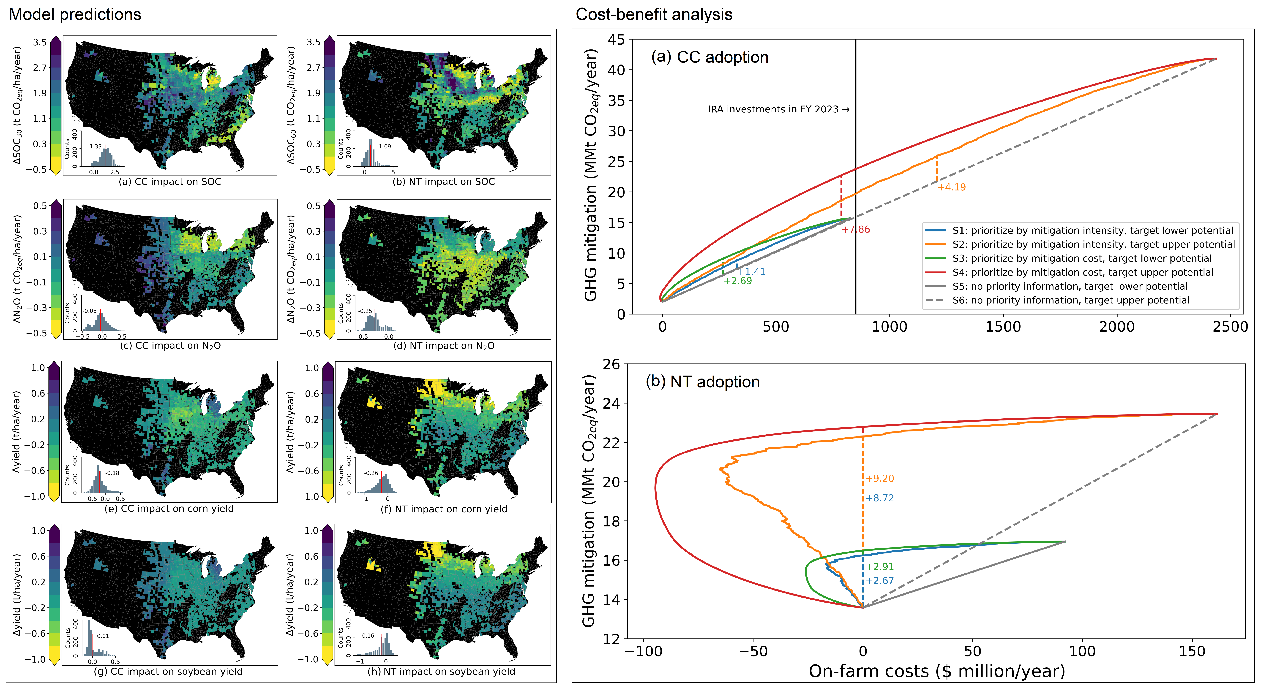As the largest terrestrial carbon pool, global soils provide great opportunity for climate change mitigation by transforming atmospheric CO2 as soil organic carbon (SOC) stocks. Agricultural soils have considerable GHG mitigation potential in many countries and regions, such as the U.S. and Europe, due to massive SOC loss during decades of intensive cultivation practices. To tap into opportunities for agricultural climate change mitigation, it requires identification and timely adoption of effective climate-smart practices globally and locally.
The recent billion-dollar U.S. Inflation Reduction Act has thrust climate-smart practices, such as Cover Crops (CC) and No-Till (NT) adoption, into the spotlight. However, there is still a large knowledge gap regarding the magnitude, distribution, and economic viability of these climate mitigation strategies. With rapid increase of public and corporation investment, it is imperative to provide transparent and rigorous estimates as to where and by how much public funds can be targeted to maximize the climate mitigation potential of CC and NT practices.
PhD candidate Yufeng Yang (Bioproducts and Biosystems Science, Engineering and Management) worked on a project called Agricultural Carbon Credit: An Enough Stimulus for Farmers to Go Green or Not as a UMII MnDRIVE PhD Graduate Assistant. This project involved compiling a large, comprehensive dataset of field measurements (962 paired observations) of SOC, N2O emissions, N leaching, and crop yield in response to CC and NT adoptions in the U.S. A random-forest-based meta-analysis approach was employed to develop transferable predictive models to provide spatially explicit estimates on ΔSOC, ΔN2O, ΔNleach, and Δyield (Δ = CC - no CC, or Δ = NT - conventional tillage). In addition, cost-benefit analyses were conducted incorporating various economic factors associated with the adoption of CC and NT, to present a detailed view of mitigation intensity and cost. The results revealed significant variations in the mitigation intensities and mitigation costs of CC and NT, pointing to substantial opportunities for optimization.
Major findings in the study include:
- The adoption of CC showed a mitigation intensity of 1.39 ± 0.5 t CO2eq/ha/year achieved at a mitigation cost of $69 ± $22 /t CO2eq while NT of 1.34 ± 0.8 t CO2eq/ha/year at $8 ± $22 /t CO2eq.
- The GHG mitigation potential of CC adoption is dominantly composed of SOC sequestration (97%), and that of NT adoption contains higher potential to reduce N2O emissions that comprises 19% of its total mitigation potential.
- The difference between the most and the least efficient incentives allocations led to 7.9 million t CO2eq/year GHG mitigation or $481 million annual economic saving for CC and 9.2 million t CO2eq/year GHG mitigation or $212 million annual saving for NT.
- The hypothesized scenarios with 100% adoption of CC and NT could provide estimated mitigation potentials of 52 ± 19 and 55 ± 23 million metric t (MMt) CO2eq/year, respectively in U.S. corn-soybean systems.
Importantly, the results emphasize prioritizing financial support to cost-effective mitigation hotspots can provide critically enhanced climate solutions. Such pivotal insights are not just relevant for the United States but can inform policy decision-making globally, in regions pursuing similar climate-smart agriculture strategies.
Mr. Yang did this research under the supervision of Assistant Professor Zhenong Jin (Bioproducts and Biosystems Engineering; MSI PI). He used MSI for large-scale storage and to compute some model variables.
Publication
- Yang, Yufeng et al. “Large opportunities for smarter choices of climate-smart agricultural practices in U.S. corn-soybean systems”. Nature Communications (Under review)
Presentation
- Yang, Yufeng et al. (2022, December). Integrative Economic Analysis of Climate Mitigations by Adopting Cover Cropping and Reduced Tillage in the Contiguous US. In AGU Fall Meeting Abstracts (Vol. 2022, pp. B55D-1012).
The UMII MnDRIVE Graduate Assistantship program supported U of M PhD candidates pursuing research at the intersection of informatics and any of the five MnDRIVE areas:
- Robotics
- Global Food
- Environment
- Brain Conditions
- Cancer Clinical Trials
This project was part of the Environment MnDRIVE area.
The UMII program was converted to the Data Science Initiative-MnDRIVE Graduate Assistantship program in the fall of 2023. Research supported by the program is at the intersection of data science and the five MnDRIVE areas. The most recent Assistantships were announced in January 2024. The application period for the next awards will be announced in Fall 2024.
Image description: Model predictions and cost-benefit analyses on the impacts of adopting cover crops (CC) and no-till (NT) on soil organic carbon (ΔSOC), N2O emissions (ΔN2O), and crop yield (Δyield). Model predictions of ΔSOC are at depth of 0-30 cm (ΔSOC30) under the adoption of CC and at depth of 0-60 cm (ΔSOC60) under the adoption of NT. The cost-benefit analysis shows the responses of the estimated GHG mitigation (million metric t CO2eq/year) to the on-farm costs ($ million/year) for the adoption of CC and NT in U.S. corn-soybean systems.
